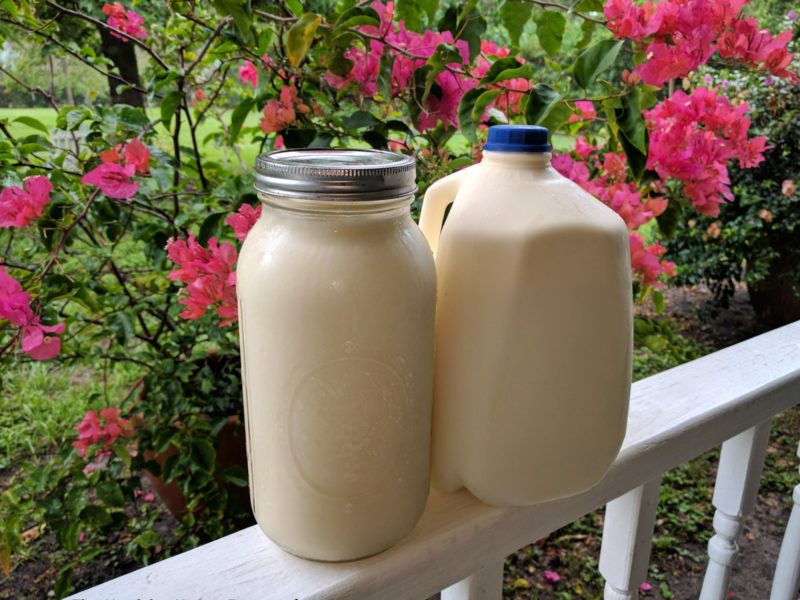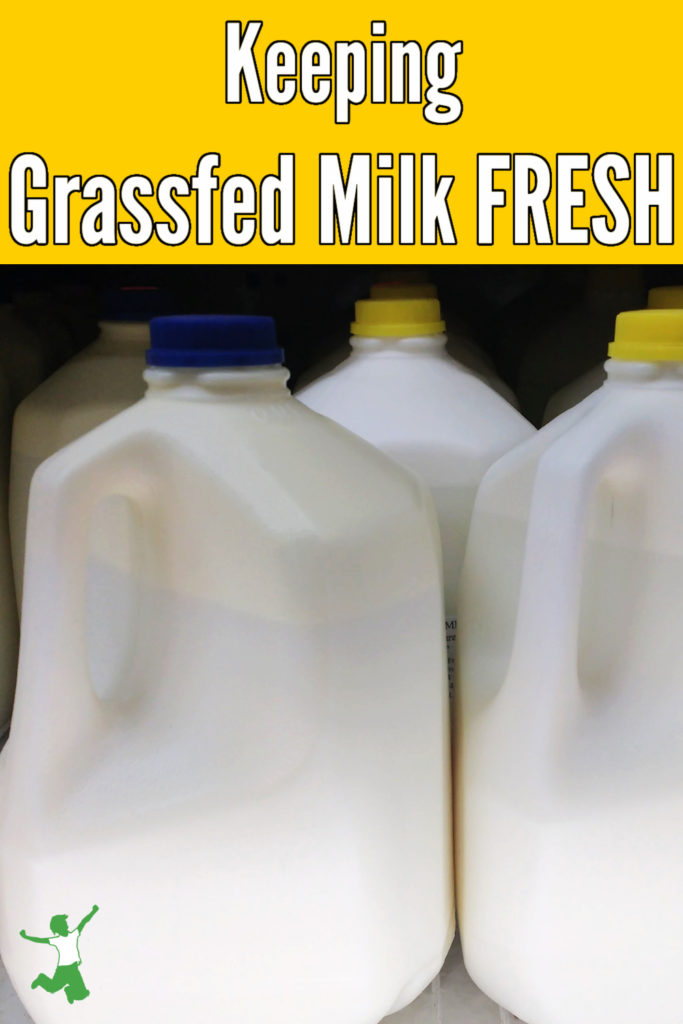How to keep grassfed raw milk fresh for drinking as long as possible so that your investment in Real Food is maximally used for your family’s health benefit.

When making the smart switch to unpasteurized milk from allergy-triggering pasteurized or ultrapasteurized (UHT) organic milk, a consumer needs to learn a few tricks of the trade right away. One of the most important is how to maintain raw milk freshness as long as possible.
Practically speaking, this is necessary because quality, fresh from the farm milk is usually at least double or even triple commercial milk prices (unless you buy at the farm and bring your own containers). You want every drop to stay fresh until you’ve used it up!
This is especially important for those who will use the grassfed milk for homemade baby formula.
As someone who has purchased and consumed raw grass-fed milk from over two dozen farms in many different states and countries over the past 2 decades, I thought I would pass along 5 important tips on how to make this happen in your home.
Quality, unpasteurized raw milk should easily remain fresh for drinking on average 10-14 days. In the summer, when the grass is mild and grows fast, I’ve found it will sometimes last 3 weeks or more.
If your farm doesn’t have milk that stays fresh this long, several things could be the problem.
A Large Creamline Locks in Raw Milk Freshness
The type of cow you get your milk from makes a huge difference to how long it lasts in the fridge.
Holstein (black and white) cows, produce milk with a decidedly small to nearly imperceptible cream line.
This is a problem for freshness because the larger the cream line, the longer the milk stays fresh for drinking. The cream very effectively locks in the freshness of the milk. Another related problem with Holstein milk is the A1 vs A2 cow genetics issue as discussed in the linked article.
Raw milk stays fresh much longer when you get it from old-fashioned cows such as jersey, guernsey, or devon among others.
If you’re not an expert at knowing a cow’s breed just by looking at her, then examine the cream line at the top of the milk.
If it isn’t at least an inch or usually two or more, then it’s probably from Holstein or Holstein-mix cows.
The cream line on the jersey milk I buy is regularly 1/3 the height of the container! No wonder this amazing milk stays fresh for so long.
Milking Protocol
Another reason for rapidly soured milk is the type of milking procedures used at the farm.
If a farm bottles the raw milk before it is cooled to 34-40 ºF/ 1-4 ºC, this can reduce how long the milk remains fresh for drinking by a few days or even a full week. The reason is that milk comes out of the cow at approximately 104 ºF/ 40 ºC. If this warm milk is put into a bottle immediately and then refrigerated, it will take HOURS for it to completely cool down.
The longer raw milk is above 40 ºF/ 4 ºC, the more rapidly it will sour. This occurs from the beneficial probiotic microbes consuming the milk sugar which gradually transforms it into a clabbered milk state.
On the other hand, rapidly cooling before bottling is a huge positive for raw milk freshness. As mentioned above, it will likely add a week or more to the drinkable life of the milk.
Bottling raw milk before it is cold is not necessarily a safety issue. It is, however, a less desirable approach. Rapid cooling before bottling ensures a quality product that lasts longer for the consumer.
Check Refrigerator Temperature
Another common reason raw milk sours quickly is due to consumer negligence. A refrigerator that stores raw milk really must be below 40 ºF/ 4 ºC. Every degree above 40 ºF/ 4 ºC will take at least a couple of days off the drinking life of the milk.
You absolutely cannot tell how cold a refrigerator is by opening it up and sticking your hand in there to gauge the temperature. The only reliable way is to measure it precisely with a fridge thermometer. I use this one.
Most people regularly have a fridge in the 40-45 ºF range and think everything is just fine. That is until they start to store raw milk and wonder why it only lasts a week or even less.
If you are having problems with maintaining raw milk freshness, please don’t complain to your farmer. At least not yet! Check your fridge first.
The ideal fridge temperature is 33-36 ºF. Even better, store bottles of raw milk that you aren’t actively using yet in a second fridge that is 33-36 ºF. This way you add the benefit of the door not getting opened and closed much which helps better maintain the optimal temperature range.
Glass Bottles are Best
Raw milk stays fresh longer in glass as opposed to plastic jugs. That said, many grass-fed farms do not offer their milk in glass bottles. This isn’t necessarily a problem.
For example, the farm I buy raw milk from only offers raw milk in plastic jugs. This is offset by the large cream line and rapid milk cooling system utilized at the farm.
If you can only get your raw milk in plastic jugs too, then simply transfer the milk into glass as soon as you get home. These inexpensive half-gallon jars work well in my experience.
You don’t have to do this, of course! Transferring milk to glass is just a helpful tip for extending the drinkable life of your raw milk. It is also a smart way to maintain raw milk freshness while you are out of town.
Freezing Raw Milk with Baking Soda
It is possible that the only raw milk available in your area is from Holstein cows, milked without modern cooling equipment, and packaged in plastic jugs.
If that is the case, you can try freezing raw milk instead of refrigerating it. This option works even if you use it to make homemade milk-based baby formula. I know a number of people that have used this approach for many years. They simply thaw one container at a time on an as-needed basis.
Freezing is also a smart approach if you need to drive a long distance to pick up your raw milk and are only able to make the trip every month or two.
The primary problem with freezing raw milk is that the cream sometimes gets a bit grainy when you thaw it out. This adds a slightly undesirable texture issue to each glass.
To avoid this problem, add 1/2 tsp baking soda to each gallon before shaking it up really well and then freezing. The baking soda helps to minimize or even eliminate any clumping of the cream when the milk is thawed.
Not sure what type of container to use for freezing? This article discusses tips on how to freeze milk in either plastic or glass with no mess or safety issues.
Do you have any other tips for maintaining unpasteurized raw milk freshness? Please share it with all of us!









Sarah, I buy an organic 100% grassfed non homogenized milk in plastic but I worry about microplastics leaching into the milk. Is it helpful just to transfer into glass once you get it? I love that the farm Alexandre Family Farm selling at Sprouts all around the country is 100% grassfed which is hard to find!
I haven’t seen any research on that to know for sure. Transferring raw milk from plastic to glass increases the length of time the milk stays fresh for drinking by quite a bit (then you clabber it and use for cooking after souring if you have any left).
Thank you!I will take your advice.Thanks again!!Good to know there are knowledgeable people able to help.
If I milk my own cow at home, what’s the best way to rapidly cool the milk? Always before, I just put it in gallon or half gallon jars as soon as I got in the house and put it in the fridge. What’s a better way to cool it down first?
Also, I have found that using a vacuum “sucker pump” to remove all the air from the jar each time I open it to get milk out seems to make the milk last much longer!
Explanation: I use gallon or half gallon glass jars with metal lids on them. I have a vacuum pump like this one:
Ziploc Vacuum Sealer Starter Kit 1 Pump + 3 Quart【2,8 L】 Freezer Bags NEW Discontinued
I poke a pin hole in the metal lid (away from any ridges/rim so I can get a good seal with the pump), then I put a small piece of black electric tape over the hole but I leave one side slightly Un sealed. Then I put the pump over that and pump the air out of the jar. I can usually re-use the same piece of tape a few times, but if it gets wet, just replace it with a new piece so it will stick down well.
Can you freeze raw cream?
Yes but the texture usually isn’t completely smooth when thawed.
Sarah!I always think about BPA/BPS in plastic jugs even if labeled BPA free.Thoughts on safety?Is it better to consume raw milk in plastic vs. not having it?
Glass is best always, but it often isn’t practical for raw milk dairies to use it. Transfering from the plastic jugs to 1/2 gallon glass mason jars when you get home is a good idea. Bonus, the milk will last longer.
Once thawed an immersion blender works wonderfully to get frozen milk and cream back to the correct texture!
Hi Sarah, thank you for the informative article. I was wondering how long raw milk could be kept frozen and still retain its high quality?
Some nutrition is lost freezing raw milk, but not much. To prevent freezer burn taste, I would suggest using within 6 months at the most.
I am new at this–I am going to MN to get it direct from a farmer. Need to bring my own jars. $5/gal! The problem is I was not going home immediately after (4 hr drive).How can I keep this at the right temp while staying in a hotel? Cooler and ice?
He scared me a little saying it can’t get above 58 or bacterial will form.
Cooler and ice should work great! We do this all the time when traveling.
How long can we keep raw cream in the fridge? The raw cream I get is super heavy and does not pour; you have to spoon it out of the jar. I won’t be able to get to the farm too often so I want to buy a frw 16 oz. jars at a time. Thank you
Thank you for these tips. I live in NJ and so not legal to sell here (unfortunately) but thankful I get a farm drop off from PA to a gym in near me.
I keep mine fresh but putting in back of refrigerator, not on the door of my fridge. We also get a weekly drop off and so I only order enough for one or two weeks.
So helpful! Thank you!
i also freeze some in mason jars if i buy more than i will use immediately.